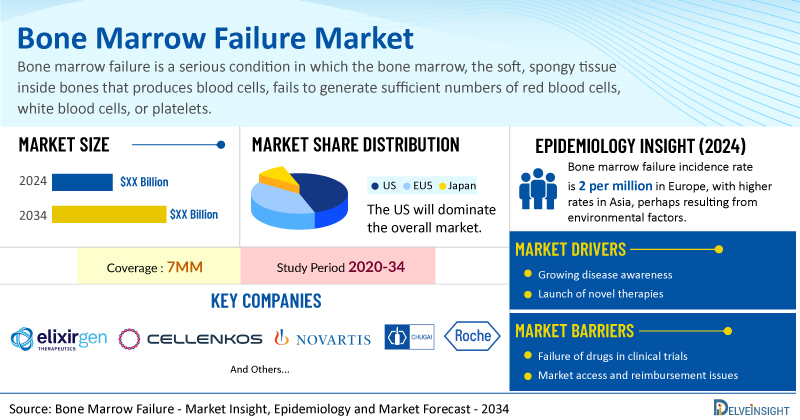Bone Marrow Failure Market Growth Accelerates with Advances in Cell and Gene Therapy | DelveInsight

New York, USA, Sept. 01, 2025 (GLOBE NEWSWIRE) -- Bone Marrow Failure Market Growth Accelerates with Advances in Cell and Gene Therapy | DelveInsightThe bone marrow failure market is witnessing steady growth driven by the increasing prevalence of aplastic anemia, myelodysplastic syndromes, and other related disorders. Advancements in stem cell transplantation, gene therapy, and immunosuppressive treatments are expanding therapeutic options and improving patient outcomes. Rising awareness, better diagnostic techniques, and supportive government initiatives are further fueling demand.DelveInsight's Bone Marrow Failure Market Insights report includes a comprehensive understanding of current treatment practices, emerging bone marrow failure drugs, market share of individual therapies, and current and forecasted bone marrow failure market size from 2020 to 2034, segmented into leading markets (the US, EU4, UK, and Japan).Bone Marrow Failure Market SummaryAccording to DelveInsight's analysis, the total bone marrow failure treatment market size is expected to grow positively by 2034 in the leading markets (the US, EU4, UK, and Japan).The United States accounts for the largest market size of Bone Marrow Failure, in comparison to EU4 (Germany, Italy, France, and Spain) and the UK, and Japan.Bone marrow failure incidence rate is 2 per million in Europe, with higher rates in Asia, perhaps resulting from environmental factors.Key bone marrow failure companies, including Elixirgen Therapeutics, Cellenkos, and others, are actively working on innovative bone marrow failure drugs. Some of the key bone marrow failure therapies in clinical trials include EXG34217, CK0801, and others. These novel bone marrow failure therapies are anticipated to enter the bone marrow failure market in the forecast period and are expected to change the market.Discover which bone marrow failure medications are expected to grab the market share @ Bone Marrow Failure Market ReportKey Factors Driving the Growth of the Bone Marrow Failure Market Rising Prevalence and Incidence of Bone Marrow Failure DisordersThe increasing number of patients diagnosed with bone marrow failure syndromes is a primary growth driver. Aging populations, greater recognition of inherited bone marrow disorders, and higher survival rates of patients with prior cancer treatments are contributing to the expansion of the market. The 5-year survival rates were 90.7% in patients aged 0–18 years, 90.5% in patients aged 19–39 years, 70.7% in patients aged 40–59 years, and 38.1% in patients aged 60 years or older.Advancements in Treatment ModalitiesTherapeutic innovation is reshaping the treatment landscape. The development of targeted therapies, gene therapy, hematopoietic stem cell transplantation (HSCT) techniques, and immunomodulatory drugs has improved survival outcomes. Novel agents addressing underlying molecular mechanisms are attracting investment and accelerating bone marrow failure market growth.Growing Stem Cell Transplantation ProceduresStem cell transplantation remains the only curative option for many bone marrow failure conditions. Expanding transplantation infrastructure, wider donor registries, and improved conditioning regimens are enabling greater adoption. Emerging approaches, such as haploidentical transplantation and cord blood use, are broadening accessibility to a larger patient pool.Increased Research and Bone Marrow Failure Clinical TrialsThe pipeline for bone marrow failure treatments is expanding, with ongoing clinical trials evaluating innovative agents, including complement inhibitors, TPO receptor agonists, and gene-editing technologies. Currently, the therapies in clinical trials for bone marrow failure include EXG34217 (Elixirgen Therapeutics), CK0801 (Cellenkos), and others.Rising Awareness and Early DiagnosisPublic health initiatives, patient advocacy groups, and physician education are leading to earlier recognition of symptoms such as unexplained anemia, infections, or bleeding. Early diagnosis facilitates timely interventions, thereby increasing demand for therapeutic options.Bone Marrow Failure Market AnalysisCurrently, two FDA-approved therapies are available for bone marrow failure: REVOLADE/PROMACTA (Novartis) and PIASKY (Chugai Pharmaceutical/Roche).REVOLADE, marketed globally under this name and as PROMACTA in the US, is an oral thrombopoietin receptor agonist indicated for thrombocytopenia and severe aplastic anemia (SAA), a form of bone marrow failure. It works by stimulating bone marrow activity to increase the production of blood cells, particularly platelets. Eltrombopag is approved for patients with SAA who do not respond to immunosuppressive therapy and can also be used in combination with antithymocyte globulin (ATG) and cyclosporine as part of select first-line regimens. In November 2018, the FDA expanded the indication for PROMACTA to include first-line treatment in combination with standard immunosuppressive therapy (IST) for adults and children aged 2 years and older with SAA. REVOLADE has also received Breakthrough Therapy Designation (BTD) for the management of radiation-induced thrombocytopenia.PIASKY (crovalimab) is a humanized monoclonal antibody that inhibits complement protein C5. By blocking its cleavage into C5a and C5b, it prevents formation of the membrane attack complex (MAC), thereby reducing intravascular hemolysis and improving symptoms in paroxysmal nocturnal hemoglobinuria (PNH). In August 2024, Roche announced European Commission approval for PIASKY as a treatment for adults and adolescents (≥12 years, ≥40 kg) with PNH, including both treatment-naïve patients and those previously treated with C5 inhibitors.Learn more about the bone marrow failure treatment options @ Bone Marrow Failure Treatment GuidelinesBone Marrow Failure Competitive LandscapeThe emerging therapies in clinical trials for bone marrow failure include EXG34217 by Elixirgen Therapeutics and CK0801 by Cellenkos.EXG-34217 is an experimental autologous gene therapy being developed by Elixirgen Therapeutics for bone marrow failure linked to telomere biology disorders (TBDs), including dyskeratosis congenita. The treatment involves modifying a patient's own CD34+ hematopoietic stem cells to express ZSCAN4, a protein that facilitates telomere extension through a telomerase-independent mechanism. By lengthening critically short telomeres, the therapy seeks to restore effective blood cell production in patients with marrow failure.In February 2025, Elixirgen Therapeutics announced that the FDA had granted Regenerative Medicine Advanced Therapy (RMAT) designation to EXG-34217 for the treatment of TBDs. Around the same time, the therapy also received Orphan Drug Designation. EXG-34217 is currently under evaluation in an ongoing Phase I/II clinical trial (NCT04211714) enrolling patients aged 12 years and older, across all genders and ethnicities, with TBD-related bone marrow failure.CK0801, developed by Cellenkos, is a first-in-class, off-the-shelf regulatory T-cell (Treg) therapy derived from cord blood. It is designed to address bone marrow failure syndromes, including aplastic anemia, by targeting the inflamed marrow microenvironment. The therapy functions by suppressing overactive cytotoxic T cells, thereby reducing inflammation and potentially reversing hematopoietic suppression.In June 2019, Cellenkos initiated a Phase I clinical trial of CK0801 in patients with bone marrow failure syndromes such as aplastic anemia, hypoplastic myelodysplasia, and primary myelofibrosis. By delivering functional Tregs, CK0801 aims to re-establish immune balance in the bone marrow and restore normal hematopoiesis.The anticipated launch of these emerging bone marrow failure therapies are poised to transform the bone marrow failure market landscape in the coming years. As these cutting-edge bone marrow failure therapies continue to mature and gain regulatory approval, they are expected to reshape the bone marrow failure market landscape, offering new standards of care and unlocking opportunities for medical innovation and economic growth.To know more about new treatment for bone marrow failure, visit @ Bone Marrow Failure Management Recent Developments in the Bone Marrow Failure MarketIn February 2025, Elixirgen Therapeutics announced that the FDA had granted Regenerative Medicine Advanced Therapy (RMAT) designation to EXG-34217, its gene therapy candidate for Telomere Biology Disorders (TBDs).In February 2025, Elixirgen Therapeutics announced that the FDA had granted Orphan Drug Designation to EXG-34217, its gene therapy candidate for the treatment of Telomere Biology Disorders (TBDs).Bone Marrow Failure OverviewBone marrow failure is a serious condition in which the bone marrow—the soft, spongy tissue inside bones that produces blood cells—fails to generate sufficient numbers of red blood cells, white blood cells, or platelets. This deficiency can cause fatigue, recurrent infections, and excessive bleeding. The disorder may arise from inherited syndromes, such as Fanconi anemia or dyskeratosis congenita, or from acquired conditions like aplastic anemia or myelodysplastic syndromes, as well as exposure to toxins, radiation, autoimmune reactions, or certain infections.Bone marrow failure is generally categorized as either acquired or inherited. Acquired forms usually develop later in life and are not present at birth. Although the exact causes remain unclear, they are often associated with chemical exposures, medications, or underlying diseases. Inherited forms, on the other hand, result from genetic mutations passed from one or both parents.Bone Marrow Failure Epidemiology SegmentationThe bone marrow failure epidemiology section provides insights into the historical and current bone marrow failure patient pool and forecasted trends for the leading markets (the US, EU4, UK, and Japan). It helps recognize the causes of current and forecasted patient trends by exploring numerous studies and views of key opinion leaders.The bone marrow failure market report proffers epidemiological analysis for the study period 2020–2034 in the leading markets (the US, EU4, UK, and Japan) segmented into:Total Incidence Cases of Bone Marrow FailureTotal inherited subtypes-specific Incident Cases of Bone Marrow FailureAge-specific Incident Cases of Bone Marrow FailureEtiology-specific Incident Cases of Bone Marrow Failure Download the report to understand which factors are driving bone marrow failure epidemiology trends @ Bone ...Full story available on Benzinga.com










